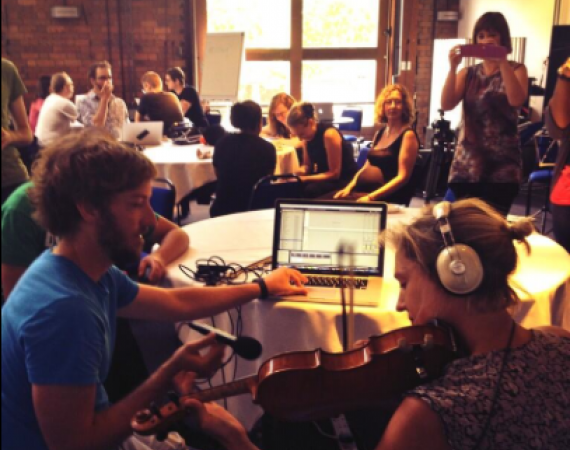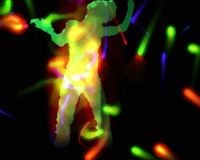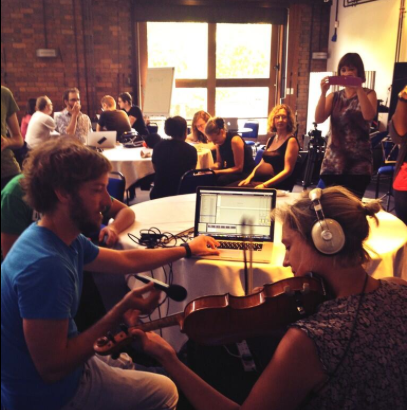Posted on Thu 26 May 2016
Day 1: Working out the questions, inventing the answers
Hack the Quartet is part of Bristol Proms, our amazing group of creatives and technologists have been here all day collaborating with the Sacconi Quartet. We're coming to the end of day one of what is our first ever hack here at Watershed, here's a glimpse into what's been going on...

Posted by
Project

Hack The Quartet
A quartet is like a game of chess; simple in its make up and infinite in its possibility. So how can new technologies be used to augment performance of and engagement with chamber music?Hack the Quartet is part of Bristol Proms, our amazing group of creatives and technologists have been here all day collaborating with the Sacconi Quartet. We're coming to the end of day one of what is our first ever hack here at Watershed, here's a glimpse into what's been going on...

After starting with breakfast, each person in the room introduced themselves, their background, and what they are particularly interested in exploring.
The range of interests is very broad, from robotics to haptics, visualisations to augmented instruments. There are those who want to use binaural recording and make the performance accessible to remote listeners, or let the audience experience the music as if they were sitting right in the centre of the quartet. Others want to make the anticipation of a piece of music somehow tangible, enhancing the experience by sharing the excitement of those who know what's coming. Some want data from the music to control things, while others want the biofeedback of the performers or even the audience to influence the creative outcomes.
Some of the craft-focused participants want to make physical objects that somehow enhance the experience. For example cast sections of the instruments to make replicas for the audience to hold, they could vibrate or light up in response to what's being played.
A certain number of the hackers want to actually influence the way the quartet play, by asking them to perform standing on one leg, creating a degenerative performance, others want to use systems to generate notation on iPads for them to read and play. One person would like to use mirrors or prisms to distort their existing notation - what kind of concerto would these methods create?
The Sacconi Quartet then introduced themselves, their 18th century instruments (two violins, a viola and a cello) and what the group are here for. As a quartet it seems they are uniquely open. When they rehearse, nothing is out of the question, they experiment to find out what works. However, as passionate performers, they often feel that after a forty minute performance the audience are no longer as passionate about the music as they are. In the 18th and 19th century, when the music they play was composed and widely performed, the audience would understand what each refrain meant and even the biographical context for the composer. It was easier for them to follow the narrative, whereas now they fear the audience don't know how they're supposed to experience it as there's no easy way for them to understand.
The aim of Bristol Proms as a whole is to find ways of breaking down these barriers, and opening up classical music to people who might otherwise feel excluded. As a quartet they are keen to experiment with the participants of the hack to work to these ends.
There are then a lot of questions aimed at the performers. Why do they look at eachother whilst performing, when other quartets do not? (Partly for communication, partly to share a feeling, conversation or conflict between the two instrumental 'characters'.) How important are their seemingly in-tune breathing patterns? (Very.) Why do they move so much while they play, and make varied facial expressions? (Everything is secondary to the music for the quartet and so they pay no particular attention to their movements and expressions, their bodies must be free to move exactly how the music dictates.)
Other questions around the hack include: How does the space affect the sound? How can the outcomes of the hack be used in music therapy? What are the 'red lines' or boundaries for the process?
Most important of all, what is there time for? The group have to quite quickly form collaborations and after hearing the quartet perform for the first time, they start by making a recording of the Mendelson piece and making it accessible to all participants. The subsequent hours have been taken up with much talking, much peering at computer screens, and the fruitful beginnings of making.
Right now I can see people working with arduinos and go-pro cameras, there's a small robotic string-plucker making a racket on the other side of the room, there are people working together in various spaces around the building making ideas come to life.
Off home now, leaving many busy people tinkering away into the night. I'll bring you more updates in the morning when I'll hopefully have insight into specific collaborations.
